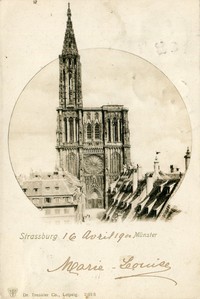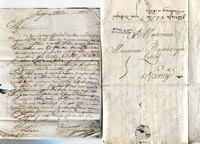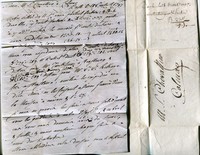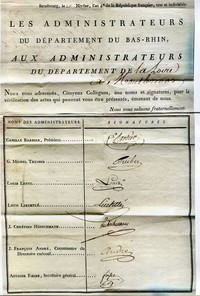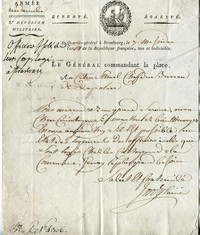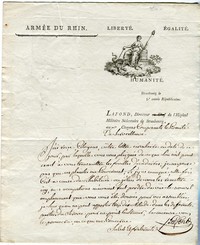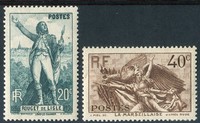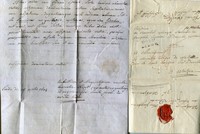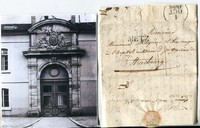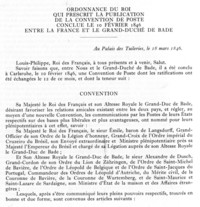Heimatsammlung (Strassburg)
The concept
Heimatsammlung is a collection about a town where you live, or which you love. Stamps, postal history, viewcards and other paper ephemera mix to make a mini-museum about one town. It is a specially German concept, which is rooted in the history and economic geography of the country.
Germany had a long history of individual States, each with a unique identity. Only on 1872 did the state of Germany come into being. Then in the following 100 years, the mixed fortunes of war brought into being new regions like the Saar and other 1920s Plebiscite territories, the annexed regions like Wartheland and the Generalgouvernement, the postwar Zones and a politically divided Germany.
The economic geography of Germany produced a relatively large number of small industrialised towns, each with a special industry and individual character. From this grew a strong sense of local interest in the history of one's birthplace or chosen town.
The material
The core of a Heimatsammlung is stamps, postal history, and viewcards. Supplementary material might include actual historic photos, engravings, firm's letter heads, maps, transport tickets, political pamphlets and other paper ephemera. There are no exact rules; the choice of supplementary material is only decided by what is relevant to the chosen subject. A Heimatsammlung collection for Hamburg or Bremen could include shipping documents and warehouse fee revenue stamps; a collection for a touristic mountain resort might offer hotel views and hunting publicity advertising stamps.
An example : STRASSBURG / STRASBOURG - a timeline......
The title here is deliberately bilingual. Sometimes German, sometimes French, the city has usually been the cultural and commercial fulcrum of links between Germany and France, but in harder times, it could be a border town garrisoned against a hostile enemy.
I'm showing here some examples, mainly from my personal collection for Strassburg/Strasbourg, to show a timeline of the city.
I have no family links with the city, but as a schoolboy became fascinated with the idea of being a "European citizen" and the aim of the Conseil de l'Europe, encouraging Europe to work together (well, there is some debate...) while keeping regional differences. A Heimatsammlung for this city shows its varying fortunes as a hub of international exchange or as a bastion of national defence.
The cathedral, in mainly high Gothic style (illustrated here on an early postcard of c1900), was largely built from 1225, but incorporates some earlier features, e.g. the choir in romanesque form. The north tower, financed by the sale of indulgences, was completed in 1439 and made the cathedral the world's tallest extant mediaeval building. The planned matching south tower was never built, owing to due to shortages of funds, changed attitudes to church building in the Reformation, and structural problems. Thus, the unusual single tower cathedral has become an instantly recognised symbol of Alsace.
1648 ATTACHMENT TO FRANCE
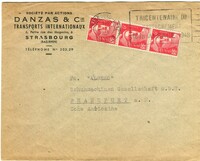
In the early 1600s, Alsace was a patchwork of German rulers loosely under the sovereignty of the Holy Roman Empire. In 1648, under the Treaty of Westphalia, Alsace was nominally transferred to France. The integration was not instant; the local Alsatian Dukes tried to maintain their independence and financial power. Bringing Alsace under French control required a century of individual negotiation and gradual imposition of a unified system of administration directed from Paris. French rulers always tended to see the theory rather than the practice. This is reflected in this 1948 cover from Strasbourg, three 6c Ceres stamps cancelled with a slogan cds proclaiming the tercentenary of the instant "attachment" of Alsace to France in 1648. However, Strasbourg itself remained a free Imperial city with allegiance to the Holy Roman Empire until 1681 when it was occupied by the army of Louis XIV and placed under more direct French administration.
1683 CLAUSA GERMANIS GALLIA
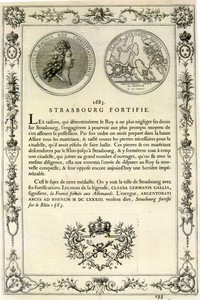
When Louis XIV captured the left bank of the Rhine in 1681, he ordered Vauban to construct elaborate fortifications at Strasbourg. A commemorative medal of 1683 bears the inscription CLAUSA GERMANIS GALLIA (The Germans are excluded from France). Source : "STRASBOURG FORTIFIE_1683.jpg, a title by Defranoux (Own work) [CC BY-SA 4.0 (http://creativecommons.org/licenses/by-sa/4.0)], via Wikimedia Commons https://commons.wikimedia.org/wiki/File: STRASBOURG_FORTIFIE_1683.jpg#/media/File STRASBOURG_FORTIFIE_1683.jpg"
This transfer of power was eventually recognised by the Holy Roman Emperor in 1697.
18th CENTURY MAIL FORWARDING AT STRASBOURG
Although Strasbourg was annexed by Louis XIV of France in 1681 and defences built against the Germans, it kept many of its commercial links with other towns of the Holy Roman Empire. However, the new régime brought a break in postal connections across the Rhine. Merchants were obliged to use trade travellers to carry mail themselves to Strasbourg, where a commercial forwarder would arrange the letter to be sent on through the French mail system, for a fee or as a favour. Shown here is a letter of 1730 from Frankfurt, carried privately to Strasbourg, where the forwarder Jean Jacques de Beyer arranged for it to be mailed through the French post ("STRAS" straightline cancel of Strasbourg) to its final destination in Nancy.
DEPARTMENT 67
The French departments were created in 1791, replacing Ancien Régime provinces, as the first administrative level below the central state. Former boundaries were changed and most departments were named after rivers or geographical features, in order to reduce old loyalties to Royalist nobility. Strasbourg became capital of Department 67, Bas Rhin (Lower Rhine) - which it still is today. Shown here is another privately carried letter, from Basel in Switzerland, put in the postal mail at "67 / STRASBOURG" and sent to Colmar, 1797.
REVOLUTIONARY ADMINISTRATION
This proclamation of 25 Nivose An 4 (15 January 1796) provides actual signatures of the seven members of the revolutionary administration of Bas-Rhin, at Strasbourg. The signatories were Camille Barbier (President), G. Michel Treiber, Louis Lentz, Louis Liechtlé, J. Chrétien Hübschmann, J. Francois André (executive commissioner of the Directoire), and Antoine Fiesse (secretary general). Examples were sent to all other departments (this one was mailed to the Dept de la Loire) so that revolutionary orders and communications from other fraternal departments could be verified as being authentic and genuine, rather than forgeries by counter-revolutionary imposters.
ARMEE DU DANUBE
The Armée du Danube was formed by Jean-Baptiste Jourdan during the Revolution, with a view of conquering the Upper Danube region. Initially repulsed by the Archduke Charles, it fell back on Strasbourg. This official letter of 7 Messidor An VII (25 June 1799) comes from this time, with its HQ in Strasbourg, and relates to requisitioning lodgings for the military. Later in 1799 this Army was regrouped with the Armée du Rhin under General Masséna and beat Austrian and Russian forces at the battle of Zurich.
ARMEE DU RHIN
The Armée du Rhin was created on 14th December 1791 to defend France's eastern frontier, where the Austrians were massing along the borders of the Rhine and threatening Strasbourg. This letter (year III of the Republic) from the Director of the Military Hospital in Strasbourg complains of the excessive demands of paperwork at a time when more critical matters were on hand.
ROUGET DE LISLE
Facing imminent attack by the Austrians, on 25th April 1792, the mayor of Strasbourg, Philippe Friedrich Dietrich, asked his guest, Claude Joseph Rouget de Lisle to compose a martial song to help rally the troops. The result, "Chanson de Guerre pour l'Armée du Rhin" (probably to a score by Viotti of Piedmont) was dedicated to Marshal Nicolas Luckner, a Bavarian fighting for the French. The words "Allons enfants de la Patrie / Le jour de gloire est arrivé..." were taken up by volunteers from Marseille, hence it acquired its common name "La Marseillaise" and eventually became the French national anthem.
Strasbourg did come under attack a few days later by the Austrian forces but they were repulsed at the Battle of Valmy. Did the song save the day? The majority of troops raised locally were German-speaking Alsatians, therefore their version of the song was "Auf, Brüder, auf dem Tag entgegen..." - another example of the mixed Franco-German nature of Alsace.
The centenary of the death of Rouget de Lisle was commemorated in 1936 by an issue of two French stamps.
NAPOLEONIC EUROPE
In 1804 Napoleon was made Emperor, and consolidated his conquests and administrative rule in the areas of Europe controlled by the French armies. The virile anticlericism of the Revolution was relaxed and frontiers became more open. A letter of 1804 demonstrates the new Europe - an ecclesiastical letter in Latin from Liège (today Belgium) to the bishop of Waitzen (today Vác in Hungary) was directed through Strasbourg to reach its destination - Strasbourg had become the transit point for the new Napoleonic Europe.
1815-24 BOURBON RESTORATION
Louis XVIII was restored to power with Allied support, following the defeat of Napoléon. The return to peace opened the doors again to trade and shipping across Europe. This letter of 1818 from DANZIG to Bordeaux reports on shipping and commodities and arrived through the French entry post office ALLEMAGNE PAR STRASBOURG, then via HAUTESANE (presumably Haute-Saone) and on to the firm Gaden & Klipsch, German shippers from Magdeburg who had based themselves as wine shippers on the Chartrons quay in Bordeaux in 1803. Another example of Franco-German enterprise with Strasbourg as the fulcrum.
MILITARY HOSPITAL
Constructed by Vauban in 1692, and extended 1731 and 1735, the hospital was still in use for its intended purpose in 1826 when this letter was written from METZ (straightline cancel) to a M. Meynier, assistant Major at the hospital.
1846 POSTAL CONVENTION WITH BADEN
- Price
- £0.00
1846 POSTAL CONVENTION WITH BADEN
An agreement was made with the Grand Duchy of Baden to establish agreed rates for cross-border mail, and to collect mail destined for mutual exchange; on the French side at the offices of Paris, Colmar, Neuf-Brisach, Saint-Louis, and Strasbourg; and on the Baden side at Freybourg, Kehl, Loerrach, and Alt-Brisach. These arrangements were set out and proclaimed by statutes from February to April 1846 and came into effect on 1st May 1846. The text of the Act is shown here (2 pages). At the same time special rates (effectively, local rates) applied to mail travelling not more than 6 miles into German territory. Strasbourg was partnered by the Act to Kehl (just across the river) and 28 German postal localities therefore now came within a cheap tariff from Strasbourg. The list of these localities is also given here. The postal treaty was part of a much larger treaty with Baden, to encourage trade and travel between the two countries. See KEHL BRIDGE a couple of entries below.
1861 OSCAR BERGER-LEVRAULT
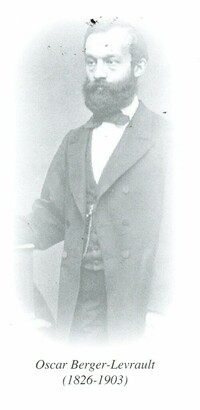
Born 1826 in Strasbourg, he became a bookseller and small publisher. He was also an early stamp collector, and published the world's first list of stamps in September 1861, with 973 stamps and postal stationery from all countries of the world, as known to him at that time. Only about 40 or 50 copies were printed, and one survives in the British Museum. After the Franco-Prussian War, he moved to Nancy, where he died in 1903.
KEHL BRIDGE
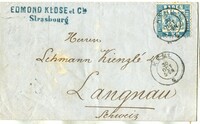
The first fixed bridge linked Strasbourg with Kell on the German side in 1388. Fortifications protected both ends. The bridge offered increased trade and contact between the two nations, but strategic defence in times of war. It continued in use for nearly four centuries, until replaced by a wooden bridge built 1803-1808 and used to celebrate Napoleon's victorious return to France after the battle of Austerlitz in 1806. Destroyed in 1815 after the defeat of Napoleon, a pontoon bridge was set up in 1816. It was convenient for merchants with business in Germany, and saved postage too. This letter of 1869 was posted by the firm of Edmond Klose in Strasbourg, but found a better rate by being posted in Kehl (with a stamp of Baden) at the cheaper 7kr rate to Langnau via Burgdorf in central Switzerland (Emmental cheese territory). This situation did not last long, war broke out with Prussia in 1870, trade ceased and Strasbourg was besieged.
1870 SWISS RED CROSS MAIL
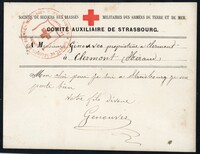
German troops under General August von Werder reached the suburbs of Strasbourg on 14th August 1870 and surrounded the city. The siege had begun. The German army was equipped with better artillery with a long range. Von Werner decided that protracted attacks on French defences would cost German lives, or a prolonged siege by starvation would take too long. His troops were needed for the intended attack on Paris. Therefore the quickest option was terror shelling of the civilian population of Strasbourg, which could lead to a quick surrender.
Artillery was trained on the city centre, rather than French fortifications. More than 200,000 shells initially killed 341 civilians, wounding a further 600 to 2000, and 10,000 inhabitants and refugees were made homeless. 861 French soldiers also died in the attacks.
On 11th September a group of Swiss Red Cross Committee members arranged an evacuation of some civilians, and also distributed post-free Red Cross mail cards to permit the first mail contact with the rest of France. A brief message could send news of safety (or otherwise). This card mailed from Strasbourg to Clermont; the writer assures his father that he is safe. The Swiss Red Cross cachet on the left of the card allowed it to travel free of charge. With German agreement, the Swiss supplied plenty of cards to distribute and plenty were written and handed in for mailing. The Germans, perhaps unhappy with the size of the response, went back on their word, and only a few were permitted to be sent. The one illustrated here did make the journey safely, with a French receiving postmark on the reverse.
1871 STRASBOURG CEDED TO GERMANY

Strasbourg, learning about the defeat at Sedan and capture of Napoleon III, Paris threatened, the impossibility of military reinforcements, and to save further deaths, officially surrendered to the German Army.
Renamed Strassburg, the city was ceded to Germany under the Treaty of Frankfurt 10 May 1871.
(Image : File:StrasbourgSiege.png from Wikipedia)
Remaining citizens could choose to move permanentky to France, or to remain ans become German nationals. Many had French as their primary language, and moved to France, although taking with them aspects of their Alsace culture and way of life. Some found success by opening restaurants with more than a touch of Alsace flavour. Today, brasseries offering beer and choucroute (sauerkraut) remain a feature of most French cities.
1872 ESSAYS FOR NETHERLANDS
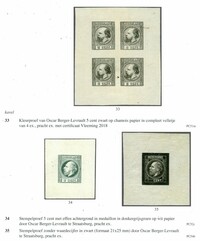
The Strasbourg publisher and stamp collector Oscar Berger-Levrault (see above) entered a competition to design the 1872 Willem III issue for the Netherlands. His essays were significantly similar to the final stamp, although a Dutch printer was finally chosen to produce the issued engraved stamps. The Berger-Levrault essays and trials exist in black and in various colours, with or without value, and a few showing additional border of colour. Corinphila veiligen av of Amsteveen offered a number of these proofs in their September 2018 auction of the Dr Albert Louis collection, with starting prices ranging fom 100 Euros to 750 Euros.
1918 LIBERATION OF STRASBOURG
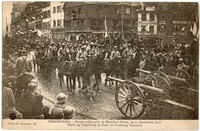
This viewcard depicts Marshall Pétain leading a column of troops at the bridge Pont du Faubourg National on 25 November 1918.
A contingent of American soldiers were also attached, and one of them mailed the card home to West Virginia. An American base camp censor cachet confirms that it s sent as soldier's mail.
1927 STRASBOURG STAMP EXHIBITION
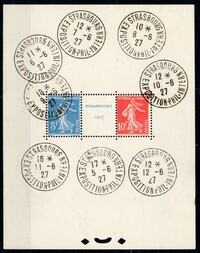
A major international stamp exhibition was held in Strasbourg in June 1927. A miniature sheet with 5F and 10F Sower design stamps could be purchased as a souvenir at the show, either to keep mint , or obtain used, in the latter case with a choice of the STRASBOURG special cancel either on the stamps, or at the side away from the stamps. Purchase of the sheet gave a right to acquire the cancel, and one intrepid visitor managed to arrange cancels from every day of the show all on the same sheet.
A total of 50,000 miniature sheets were printed. After the show, these could also be purchased by collectors through certain post offices but only for a limited time, until 12th June, when they were withdrawn. The exact quantity sold is not known, but from evidence of items in auction or on the internet, of those sold, around half were used and with the special postmark. It was allowed to have the postmark either cancelling the stamps, or to one side in the margins, either way counted as "used" and occurrence is about similar for either position. However the daily application of the special cancel on one sheet as illustrated was not normally possible; this example may be unique.
1932 SOFIA-STRASBOURG FLIGHT

The 1930s were a period when thoughts were on the increasing possibilities of air flight. The 1932 Strasbourg Philatelic Exhibition organisers tried to arrange a special flight between Sofia, Bulgaria, and Strasbourg. Suddenly far away places were getting more accessible. For Strasbourg, it showed the city at a new hub of European air connections. For Bulgaria it was also a coup, putting Bulgaria on the map with better connections to western Europe. The Bulgarian post office issued a set of three airmail stamps, depicting a a Junkers G31 over Rila Monastery. 30,000 sets were produced, valid for postage only on the special flight service between 11th and 20th May 1932. The 18 lev stamp was intended for mail to be carried as far as Strasbourg, the 24 lev stamp included the extra leg on to Paris, and the 28 lev stamp included the onwards flight from Strasbourg to Lyon and then Marseille. 9000 sets were sold to the public, and the remaining 21,000 sets were withdrawn and apparently still lie in the state archives. Unfortunately there were problems arranging the flight and mail posted bearing these stamps, intended for the special flight, was actually sent by regular mail service (train) to the destinations. Collectors also arranged for full sets to be sent on ordinary covers. Current stamp catalogues show the mint set valued at about twice the used price, perhaps because of its thematic appeal (where mint stamps are more in demand). However, used stamps are actually scarcer and also harder to find in full sets.
The route had already been planned since the 1920s by the Franco-Romanian Aviation Company, who in the 1930s developed into CIDNA (Compagnie Internationale de Navigation Aérienne), operating the route Paris-Strasbourg-Prague-Vienna-Budapest-Belgrade-Sofia, then with an option to Bucharest and Istanbul, or to Salonica and Athens. This roughly matched the route of the Orient Express (usually a train journey of three days) but CIDNA advertised their "Flêche d'Orient" air route as "Passengers,Freight, Post - in a single day". In the same year as the 1932 Sofia-Strasbourg flight, Paul Morand brought out a popular novel (French aviators wager a Russian in exile in Paris that it is possible to travel from Paris to Bucharest in the same day - and they win the bet).
1940 GERMAN OCCUPATION
Prior to the outbreak of war, the city of Strasbourg had been fortified as part of the Maginot Line. With its large civilian population right on the frontier with Germany, Strasbourg was still seen as dangerously vulnerable. As soon as war was declared on 3rd September 1939, all citizens were evacuated, leaving only active French troops in the city. France accepted defeat in June 1940 and the French troops were interned, replaced by German troops instead. Strasbourg, as part of Alsace-Lorraine, became a part of Germany.
Accordingly, a German-run postal service replaced that of France. Available stocks of French stamps were initially used, also German stamps in the hands of soldiers were considered valid for use in the occupied territory. Hindenburg stamps overprinted ELSASS were put on sale 15th August 1940, in line with Alsace becoming a German Gau under the leadership of Robert Heinrich Wagner. Under his administration, a severe policy of Germanification followed (e.g. prohibition of the French language, destruction of the large synagogue, using the university to create studies claiming "racial degeneracy" of the Jews).
From 26th August 1940 a new tariff in German currency came in :
3pf = printed paper
6pf = postcards
8pf = local letters
12pf = letters for the rest of the Reich
25pf = foreign letters
(The above rates were for the first weight step; heavier letters, packets, and special service mail required higher postage).
On this date, any French stamps in circulation were declared invalid.
Germany stamps retained their validity, and by definition included those for German Lorraine, German Luxemburg, and even Danzig stamps from the last years when part of the Reich.
Evacuees were first allowed to return in July 1940, as long as they were of Alsation origin. Some philatelists among the returning evacuees created mixed franking covers, even managing a Lorraine and Danzig combination. Such covers, whilst fully valid by postal regulations, have a strong philatelic flavour, and are sometimes overfranked.
The Alsace surcharged set were withdrawn on 31st December 1942 and remaining stocks destroyed. From 1st January 1942, only stamps of the German Reich were allowed for postage.
MORE INTENDED...
This philatelic timeline on Strasbourg is a continuing story. More will be launched as my hobby time permits! Keep an eye on the website!

